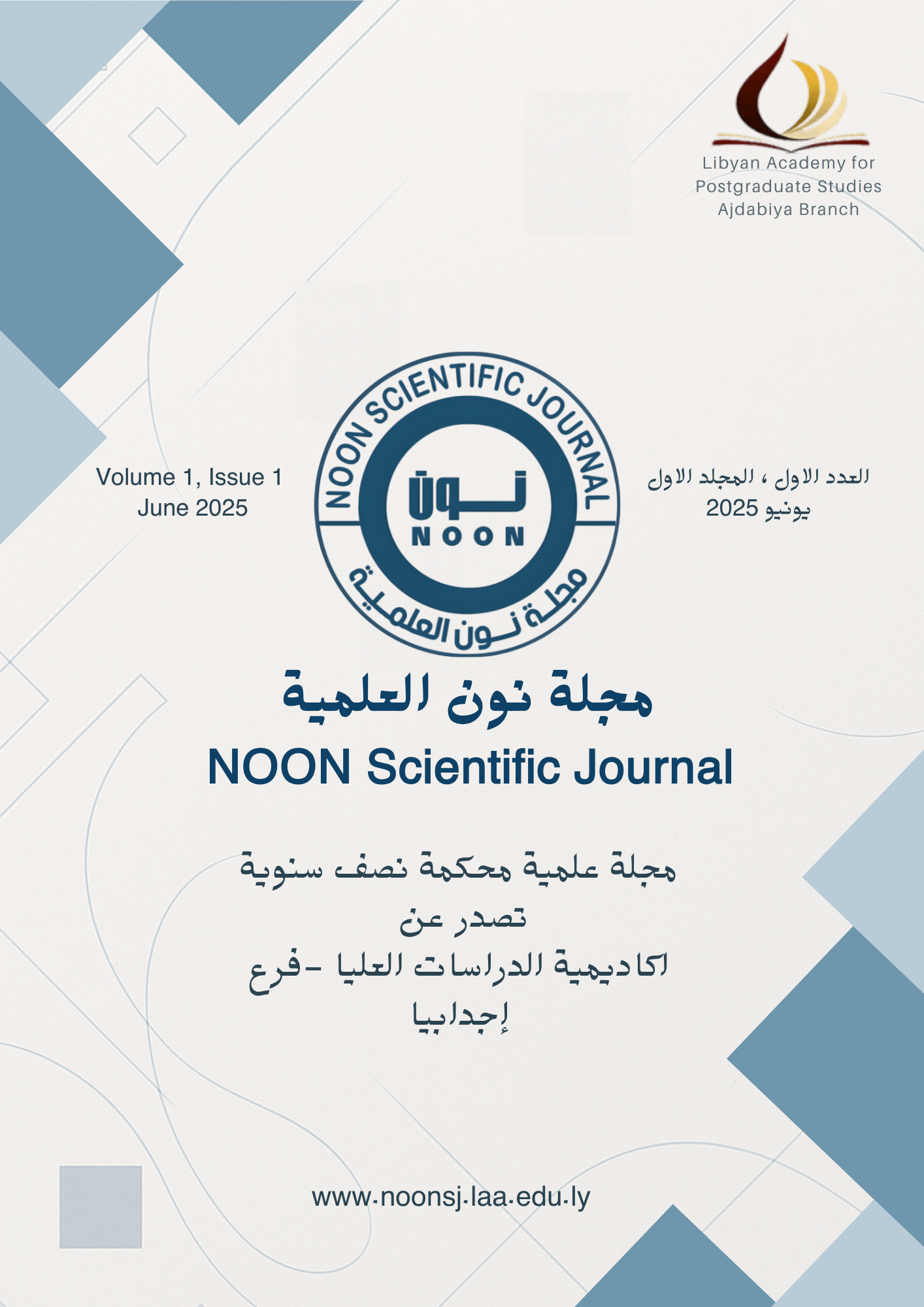Home \ Archives\vol 1, No 1, 2025\ Articles
العوامل الرئيسة التي تعيق التعليم الالكتروني من وجهة نظر المشرفين والمعلمين والطلبة في المدراس الثانوية – مدينة نالوت، ليبيا
- سعيد أحمد السيفاو
- قسم التقنية الكيميائية، كلية العوم والتقنية، مدينة جادو، ليبيا
DOI: 10.64587/NSJAPGSss
Volume (1), Issue (1) , June 2025

Published: 06/30/2025
الملخص: من خلال تحديد للصعوبات والتحديات والعوامل التي تعيق تطبيق التعليم الإلكتروني لمادة الكيمياء لطلبة الثانوية العامة من وجهة نظر المشرفين والمعلمين والطلبة في المدارس الثانوية في مدينة نالوت الليبية، والتي تضمنت أربعة عوامل رئيسية: الصعوبات فردية وصعوبات السياقات و صعوبات تكنولوجية و صعوبات المنهج الدراسي إلى جانب العوامل الفرعية والمتغيرات الديموغرافية المرتبطة بها، و من للتحليل الوصفي للتعرف على درجة الصعوبات الفردية وصعوبات التكنولوجيا و السياقات، وكذلك صعوبات المنهج الدراسي و درجة الارتباطية بين الصعوبات و قوة تأثير صعوبات كل من الفرد، السياقات، والتكنولوجيا، المنهج الدراسي في التعليم. وجدت الدراسة علاقة ارتباطية بين صعوبات كل من السياقات، والتكنولوجيا والمنهج الدراسي والصعوبات الفردية ومن استنتاج علاقة تأثيرية لعوامل فرعية لكل مجال من الصعوبات على النحو الآتي :صعوبات الأفراد الإمكانات الفردية، والتوجه والدافع وصعوبات السياقات المؤسسية والاجتماعية والثقافية ، وصعوبات التكنولوجيا التكلفة، والتقنية ، وصعوبات المنهج الدراسي جودة المحتوى والتوظيف. تقدم هذه الدراسة إطار مفاهيمي لصعوبات للتعليم الإلكتروني الذي يمكن أن يستخدم من قبل المهتمين بتطوير التعليم الإلكتروني
الكلمات المفتاحية: المعوقات، التعلم الإلكتروني، تطوير
المصادر او المراجع
أولا المراجع العربية:
إبراهيم، احمد. & مدهوش، عبد القادر. & فرحان، براء .(2019) معوقات تطبيق التعليم الالكتروني في كلية الأعلام جامعة ذي قار .مجلة لارك للفلسفة واللسانيات والعلوم الاجتماعية. 2 :(33) .306-315
الشبه، رمضان. & حدود، مصطفى. .(2015) أسباب عدم التوافق بين مخرجات التعليم الجامعي و متطلبات سوق العمل في ليبيا. المجلة الجامعة. :(13)3 .108-75
العريفي، يوسف .(2003) التعليم الإلكتروني تقنية رائده وطريقة واعدة .الندوة الأولى للتعليم الالكتروني: الرياض-السعودية.
العمري، محمد .(2014) درجة استخدام تطبيقات التعلم النّقال لدى طلبة الدراسات العليا في جامعة اليرموك ومعوقات استخدامها.
مجلة المناره للبحوث والدراسات. 20 .(1)
الزيتون، محمود .(2004) أساليب تدريس العلوم. الطبعة الأولى. دار الشروق للنشر: عمَّان- الأردن.
علي، بسمة. & جورج، جورجيت. & مرجان، رانيا. & حنفي، محمد (2017) . متطلبات تفعيل التعليم الإلكتروني بمرحلة التعليم الثانوي العام لمواجهة مشكلة الدروس الخصوصية بمحافظة بورسعيد. مجلة كلية التربية. :(2)22 .803-774
ثانيا المراجع الأجنبية:
Abbad, M.M., Morris, D., & De Nahlik, C. (2009). Looking under the bonnet: Factors affecting student adoption of e-learning systems in Jordan. The International Review of Research in Open and Distributed Learning, The International Review of Research in Open and Distance Learning, 10(2), https://doi.org/10.19173/irrodl.v10i2.596
Abd‐El‐Khalick, F., & Akerson, L.V. (2007). On the role and use of “theory” in science education research: A response to Johnston, Southerland, and Sowell. Science Education, 91(1): 187-194, https://doi.org/10.1002/sce.20189
AbuSneineh, W., & Zairi, M. (2010). An evaluation framework for E-learning effectiveness in the Arab World, International Encyclopedia of Education, 521-535, DOI:10.1016/B978-0-08-044894- 7.01708-5
Aldowah, H., Ghazal, S., & Umar, I. (2018). Instructors’ Challenges in Implementing E-learning in a Public University in Yemen. The Turkish Online Journal of Design Art and Communication, 8, 1138- 1146, DOI:10.7456/1080SSE/155
Al-Fadhli, S. (2008). Students’ Perceptions of E-learning in Arab Society: Kuwait University as a case study, E-Learning and Digital Media, 5(4): 418-428.
Almansuri, A.A. (2018). Libya E-Learning in the Middle East and North Africa (MENA) Region (pp. 243-260). Gewerbestrasse: Springer International Publishing.
Andersson, A., & Grönlund, Å. (2009). A conceptual framework for e‐learning in developing countries: A critical review of research challenges. The electronic Journal of information systems in developing Countries, 38(1): 1-16, https://doi.org/10.1002/j.1681-4835.2009.tb00271.x
Ashraf, S., Khan, T.A., & Rehman, I. (2016). E-Learning for Secondary and Higher Education Sectors: A Survey. International Journal of Advanced Computer Science and Applications, 7(9): 275- 283, DOI: 10.14569/IJACSA.2016.07093
Caliendo, S.M., & Kyle, W.C. (1996). Editorial: Establishing the theoretical frame. Journal of Research in Science Teaching, 33(3): 225-227.
Cohen, Barney, Jessor, Richard, Reed, Holly, Lloyd, Cynthia B., Behrman, J., & Lam, D. (2005). Conceptual framework (pp. 32-63): Cynthia B. Lloyd. Washington, DC: National Academies Press.
Fallon, C., & Brown, S. (2003). E-Learning standards: A guide to purchasing, developing, and deploying standards-conformant E. Learning.
Hassanzadeh, A., Kanaani, F., & Elahi, S. (2012). A model for measuring e-learning systems success in universities. Expert Systems with Applications, 39(12): 10959-10966. https://doi.org/10.1016/j.eswa.2012.03.028
Honey, P. (2001). E-learning: a performance appraisal and some suggestions for improvement. The Learning Organization: An International Journal, 8(5): 200-203. DOI: https://doi.org/10.1108/EUM0000000005913
Horton, W., & Horton, K. (2003). E-learning tools and technologies: A consumer’s guide for trainers, teachers, educators, and instructional designers. United States of America: John Wiley.
Huberman, A.M., & Miles, M.B. (1994). Data management and analysis methods. In
N.K. Denzin, & Y.S. Lincoln (Eds.), Handbook of Qualitative Research (pp. 428-444). Thousand Oaks, CA: Sage Publications.
Kwofie, B., & Henten, A. (2011). The advantages and challenges of e-learning implementation: The story of a developing nation. Paper presented at the 3rd World Conference on Education Sciences (WCES-2011), Bahcesehir University, Istanbul, Turkey.
Malik, M.W. (2010). Factor effecting learner’s satisfaction towards e-learning: a conceptual framework. OIDA International Journal of Sustainable Development, 2(3): 77-82.
Mertens, D.M. (2005). Research and evaluation in education and psychology: Integrating diversity with quantitative, qualitative, and mixed methods (2nd editio). Thousand Oaks, CA: Sage.
Musa, M.A., & Othman, M.S. (2012). Critical success factor in e-Learning: an examination of technology and student factors. International Journal of Advances in Engineering & Technology, 3(2): 140-148.
Othman, A., Pislaru, C., Kenan, T., & Impes, A. (2013). Analysing the effectiveness of IT strategy in Libyan higher education institutes. International Journal of Digital Information and Wireless Communications (IJDIWC), 3(3): 114-129.
Puri, G. (2012). Critical success Factors in e-Learning – An empirical study. International Journal of Multidisciplinary Research, 2(1):149-161.
Selim, H.M. (2007). Critical success factors for e-learning acceptance: Confirmatory factor models. Computers & Education, 49(2): 396-413, DOI: 10.1016/j.compedu.2005.09.004
Sun, K., Lin, Y., & Yu, C. (2008). A study on learning effect among different learning styles in a Web-based lab of science for elementary school students. Computers & Education, 50(4): 1411-1422, DOI:10.1016/j.compedu.2007.01.003
Pei-Chen, S., Tsai, R.J., Finger, G., Yueh-Yang, C., & Yeh, D. (2008). What drives a successful e- Learning? An empirical investigation of the critical factors influencing learner satisfaction, Computers & Education, 50(4): 1183-1202, DOI: 10.1016/j.compedu.2006.11.007
Taghavi, M. (2013). A critical analysis of higher education sector in Libya: A socio-economic analysis. Procedia-Social and Behavioral Sciences, 29, 742-751.
Welsh, E.T., Wanberg, C.R., Brown, K.G., & Simmering, M.J. (2003). E‐learning: emerging uses, empirical results and future directions. International Journal of Training and Development, 7(4): 245- 258, https://doi.org/10.1046/j.1360-3736.2003.00184.x
Zhu, C., Valcke, M., Schellens, T., & Li, Y. (2009). Chinese students’ perceptions of a collaborative e-learning environment and factors affecting their performance: implementing a Flemish e-learning course in a Chinese educational context. Asia Pacific Education Review, 10(2): 225-235, DOI 10.1007/s12564-009-9021-4
